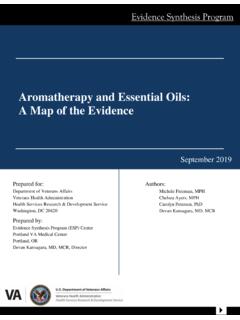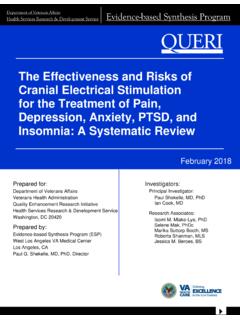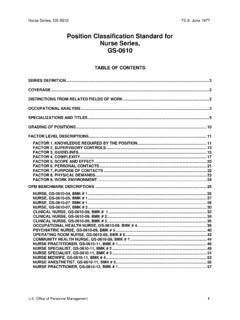Transcription of Early Warning System Scores: A Systematic Review
1 Evidence-based Synthesis Program Department of Veterans AffairsHealth Services Research & Development ServiceJanuary 2014 Prepared for:Department of Veterans AffairsVeterans Health AdministrationHealth Services Research & Development ServiceWashington, DC 20420 Prepared by:Evidence-based Synthesis Program (ESP) CenterPortland VA Medical CenterPortland, ORDevan Kansagara, MD, MCR, DirectorInvestigators:Principal Investigator:M. E. Beth Smith, DOCo-InvestigatorsJoseph C Chiovaro, MDMaya O Neil, PhDDevan Kansagara, MD, MCRAna Quinones, PhDMichele Freeman, MPHM akalapua Motu apuaka, BSChristopher G Slatore, MD, MS4 Early Warning System Scores: A Systematic ReviewEarly Warning System Scores: A Systematic Review Evidence-based Synthesis Programi9 CONTENTS34 PREFACEQ uality Enhancement Research Initiative s (QUERI) Evidence-based Synthesis Program (ESP) was established to provide timely and accurate syntheses of targeted healthcare topics of particular importance to Veterans Affairs (VA) managers and policymakers, as they work to improve the health and healthcare of Veterans.
2 The ESP disseminates these reports throughout the provides funding for 4 ESP Centers and each Center has an active VA affiliation. The ESP Centers generate evidence syntheses on important clinical practice topics, and these reports help: develop clinical policies informed by evidence, guide the implementation of effective services to improve patient outcomes and to support VA clinical practice guidelines and performance measures, and set the direction for future research to address gaps in clinical 2009, the ESP Coordinating Center was created to expand the capacity of QUERI Central Office and the 4 ESP sites by developing and maintaining program processes. In addition, the Center established a Steering Committee comprised of QUERI field-based investigators, VA Patient Care Services, Office of Quality and Performance, and Veterans Integrated Service Networks (VISN) Clinical Management Officers. The Steering Committee provides program oversight, guides strategic planning, coordinates dissemination activities, and develops collaborations with VA leadership to identify new ESP topics of importance to Veterans and the VA healthcare on this evidence report are welcome and can be sent to Nicole Floyd, ESP Coordinating Center Program Manager, at citation: Smith MEB, Chiovaro J, O Neil M, Kansagara D, Quinones A, Freeman M, Motu apuaka M, Slatore CG.
3 Early Warning Scoring Systems: A Systematic Review . VA-ESP Project #05-225; 2013 This report is based on research conducted by the Evidence-based Synthesis Program (ESP) Center located at the Portland VA Medical Center, Portland OR funded by the Department of Veterans Affairs, Veterans Health Administration, Office of Research and Development, Quality Enhancement Research Initiative. The findings and conclusions in this document are those of the author(s) who are responsible for its contents; the findings and conclusions do not necessarily represent the views of the Department of Veterans Affairs or the United States government. Therefore, no statement in this article should be construed as an official position of the Department of Veterans Affairs. No investigators have any affiliations or financial involvement ( , employment, consultancies, honoraria, stock ownership or options, expert testimony, grants or patents received or pending, or royalties) that conflict with material presented in the Warning System Scores: A Systematic Review Evidence-based Synthesis Programiii9 CONTENTS34 TABLE OF CONTENTS BACKGROUND.
4 1 METHODST opic development ..2 Key question #1 ..2 Key question #2 ..2 Search strategy ..4 Study selection ..4 Data abstraction and quality assessment ..4 Data synthesis ..5 Role of the funding source ..5 RESULTSL iterature flow ..6 Predictive value of EWS ..8 Impact of EWS interventions ..13 Impact of EWS on health outcomes ..13 Mortality ..13 Cardiac arrest ..13 Impact of EWS on resources ..14 Length of hospital stay ..14 Admissions to the intensive care unit ..14 Use of rapid response and code teams ..15 Nursing ..15 DISCUSSION ..22 Conclusion ..24 REFERENCES ..25 FIGURESF igure 1. Analytic framework ..3 Figure 2. Literature flow diagram ..6 TABLEST able 1. Parameters used in studies of the predictive ability and effectiveness of Early Warning scoring systems for clinical deterioration in medical and surgical inpatients ..7 Table 2. Observational studies of the predictive value of EWS scores.
5 10 Table 3. Assessment of study methods for potential sources of bias in studies of the predictive value of EWS scores ..12 Table 4. Studies of the impact of EWS interventions on patient outcomes and resource utilization ..16 APPENDIX A. SEARCH STRATEGIES ..33 APPENDIX B. INCLUSION/EXCLUSION CRITERIA ..35 APPENDIX C. PEER Review COMMENTS AND RESPONSES ..36 Early Warning System Scores: A Systematic Review Evidence-based Synthesis Program19 CONTENTS34 BACKGROUNDE arly Warning System (EWS) scores are tools used by hospital care teams to recognize the Early signs of clinical deterioration in order to initiate Early intervention and management, such as increasing nursing attention, informing the provider, or activating a rapid response or medical emergency These tools involve assigning a numeric value to several physiologic parameters ( , systolic blood pressure, heart rate, oxygen saturation, respiratory rate, level of consciousness, and urine output) to derive a composite score that is used to identify a patient at risk of deterioration.
6 Most are based on an aggregate weighted System in which the elements are assigned different points for the degree of physiological abnormality. Observational studies suggest that patients often show signs of clinical deterioration up to 24 hours prior to a serious clinical event requiring an intensive Delays in treatment or inadequate care of patients on general hospital wards may result in increased admissions to the intensive care unit (ICU), increased length of hospital stay, cardiac arrest, or The purpose of the EWS scores is to ensure timely and appropriate management of deteriorating patients on general hospital wards. This is potentially a significant topic for the VA, as the Portland, Oregon VA Medical Center has implemented a Modified Early Warning System (MEWS) and there are plans to implement this nationally. This evidence Review will be used by the Office of Nursing Services Clinical Practice Programs ICU Workgroup to develop guidelines for the development and implementation of EWS scores at facilities within the VA System and will be used to identify gaps in evidence that warrant further Warning System Scores: A Systematic Review Evidence-based Synthesis Program29 CONTENTS34 METHODSTOPIC DEVELOPMENTWe followed a standard protocol for Systematic reviews and developed an analytic framework (Figure 1) with input from key informants (clinicians, nurses, hospital administration and patient advocates) to answer the following key questions:Key Question 1.
7 In adult patients admitted to the general medicine or surgical wards, what is the predictive value of EWS scores for patient health outcomes within 48 hours of data collection, including short-term mortality (all cause or disease specific), cardiac arrest and pulmonary arrest? Which factors contribute to the predictive ability of EWS scores and does predictive ability vary with specific subgroups of patients? Key Question 2A: What is the impact of using Early Warning Systems on patient health outcomes including 30-day mortality, cardiovascular events (cardiac arrest, acute coronary syndrome and cardiogenic shock), use of vasopressors, number of ventilator days, respiratory failure and length of hospital stay? Key Question 2B: What is the impact of EWS on resource utilization including but not limited to admissions to the intensive care unit (ICU), length of hospital stay, and use of Rapid Response Teams (RRT)?
8 We met regularly throughout the Review with members of a technical expert panel, some of whom served as key informants during the development phase, to oversee the clinical applicability, content completeness, and methodological rigor of the Review population comprises adults admitted to the general medicine or surgical wards. Interventions include any Early Warning System scoring or other established scoring System designed to identify deteriorating patients on hospital wards, including but not limited to Modified Early Warnings Systems (MEWS), Patient at Risk (PAR) score, Physiological Scoring Systems (PSS), Vital Sign Score (VSS), Manchester Triage System , BioSign, VitalPAC Early Warning Score (ViEWS) and Physiological Observation Track and Trigger System (POTTS).3 Early Warning System Scores: A Systematic Review Evidence-based Synthesis Program9 CONTENTS34 Figure 1. Analytic FrameworkEarly Warning System Scores: A Systematic Review Evidence-based Synthesis Program FIGURE 1.
9 ANALYTIC FRAMEWORK Modifying factors patient subgroup vital signs timing of use hospital characteristics Outcomes mortality CV outcomes respiratory failure functional status discharged to location utilization length of stay hospital , ICU number of ventilator days Intermediate actions RRT ICU RN call MD call increased surveillance resource utilization decisional conflictEWS in patients hospitalized on generalmedicine and surgical wards EWS score Low risk High risk KQ2 BKQ2 AKQ1 Early Warning System Scores: A Systematic Review Evidence-based Synthesis Program49 CONTENTS34 SEARCH STRATEGYWe searched MEDLINE, CINAHL, and the Cochrane Central Register of Controlled Trials for literature published from database inception to April 2013. We searched for English-language studies of EWS in medical and surgical ward populations. Appendix A provides the search strategy in detail. We obtained additional articles from Systematic reviews, reference lists of pertinent studies, reviews, editorials, and by consulting experts.
10 All citations were imported into an electronic database (EndNote X4).STUDY SELECTIONWe included English language articles that provided primary data relevant to either key question. For studies on predictive value, we included hospital settings including the emergency department (ED). For studies on the impact of EWS intervention, we excluded studies conducted in settings other than the general medicine or surgical wards such as the emergency department (ED), and studies that did not include outcomes (opinion articles, descriptive/discussion articles, and consensus statements) or that examined outcomes outside of the proposed scope of work ( , impact on time interval of activating Rapid Response Team). A team of investigators individually reviewed citations and abstracts identified from electronic literature searches; if at least one reviewer indicated that a citation might be relevant, a second reviewer screened the citation for concordance.












